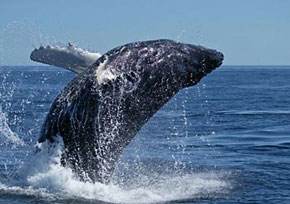 Giants Migrate Along the Sonoma Coast at Bodega Bay
Giants Migrate Along the Sonoma Coast at Bodega Bay
The epic migration of whales peaks from January through May, but is visible during much of the year. Each year gray and blue whales travel south from the Chukchi Sea near Alaska and down to Baja California for winter, then back north for the summer feeding season. A great vantage point is the Ocean Overlook at Bodega Head (see directions below), or various whale watching boat trips launching from the local area.
Gray Whales are particularly easy to observe, as they are a coastal species and stay around the continental shelf. These whales have a particular feeding habit. They stir up the ocean floor in shallow coastal areas, sucking in the bottom dwelling creatures, mostly amphipods (related to shrimp).
They dive as deep as 500 feet for 30 minutes, roll onto their side, and stick their heads a few inches into the ocean floor. Muddy plumes of water are often seen where they feed. On average these whales eat a ton of this food in a day. That is plenty more than any human could ever imagine! Even considering the massive Christmas dinners or summer barbeques after which we may feel like we have eaten a ton! What is interesting is that these gigantic creatures manage to eat a staggering amount of some of the smallest things in the ocean.
While they are most easily seen in late winter and spring while headed north, they may be seen year-round on the Sonoma Coast. They may move south as early as the end of August, or as late as early into the next year. Sometimes they overlap migration patterns, with some whales still heading south while others are already returning north.
Medium-sized for whales, the Gray Whale reaches up to about 45 feet in length and about 75,000 pounds in weight. Their tongues alone weigh around 500 pounds.
Blue Whales have very different habits. They prefer the cold, deep waters where krill shrimp thrive during the summer feeding season. The other 8 months of the year they live from stored fat.
A Blue Whale can be as long as 100 feet, up to 300,000 pounds, and bigger than 25 elephants, or a Brontosaurus and Tyrannosaurus Rex combined! A calf can grow 200 pounds in 24 hours.
They are solitary mammals, sometimes keeping to family pairs, only occasionally feeding together in larger groups.
Other interesting facts about whales:
Hearing is a heightened sense, as sound travels 4 times faster in water than in air, and farther. Blue Whales have deep voices that can vocalize at up to 180 decibels, the loudest of any animal. It is believed that these communications can travel thousands of miles across the ocean.
Gray Whales travel about 80 miles a day, stopping 6 or 7 times each day for 30 minute rests.
Spouts of steam from whales shoot up to 12 feet from water level. You may also see whales “spyhopping”, that is sticking their heads above water, perhaps to get bearings or use gravity to assist swallowing.
Since protection of Gray Whales came in 1946, the population has rebounded from about 2,000 to over 21,000 individuals. This may have been the norm before people arrived; in 1994, as a result of the recovery, Gray Whales were removed from the Endangered Species List.
Directions to Bodega Head Whale Watching:
Drive one mile north from the Visitors Center located on Highway One
Turn LEFT onto Eastshore Road
Turn RIGHT onto Bay Flat/Westshore Road
Drive 3 miles, and take the RIGHT FORK to the Ocean Overlook.
Stewards of the Coast Volunteers are on site every Saturday & Sunday, Noon-4pm, January through May as weather permits, excepting Easter and Fisherman’s Festival.
